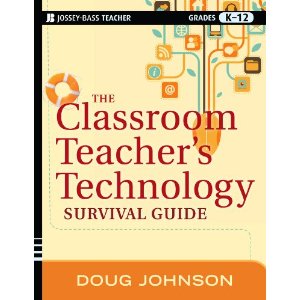Computer Diversity
Computer Diversity
Head for the Edge, January 1997
Parents often ask me what type of computer they should by for their home - a Macintosh or Wintel (Windows operating system/Intel processing chip). My advice, which is not original, is to buy the same kind of computer one’s most computer savvy friend owns. That way when the learning curve gets steep, there will be a ready tow.
When schools consider what kind of computer to buy for staff and student use, the answer to such a question is more complex. The effective expenditure of thousands, hundreds of thousands, and for some districts, millions of dollars rests on a thoughtful answer.
In lots of ways, the Mac vs. Wintel argument reminds me of those debates I engaged in the schoolyard as a boy: “Which car is better - a Ford or a Chevy?” One’s side was generally determined by the brand car one’s father drove, and most discussion was notably light on both facts and logic.
Just as either an Impala or Galaxy would get you from point A to point B, whether to buy Macs or Wintels is to a large extent a non-issue:
- You can do about the same things with both a Macintosh and Wintel computer of similar configuration. It’s software that makes the computer sing and dance. A scan of an educational software catalog and lists of award winning educational software will quickly tell you that 95% of the most popular software is written for multiple platforms. This happily includes shareware and freeware like Netscape, Explorer, Acrobat Reader, Eudora, etc. Even the staunchest Mac or Wintel fan has to admit that once a program is launched and running, it’s tough to tell them apart on screen. Our district has a policy that we will adopt only “general use” software which runs on both Mac and Wintel systems. Even if our schools were sole platform, I believe we’d still keep this policy. Our students’ homes will have a variety of computers for many years.
- Macintosh and Wintel computers of similar configurations usually cost about the same. It’s not hard to buy a cheap computer. It is hard to buy a cheap computer which has enough processing power, memory, drives and goodies like sound cards to run the latest, most hardware-demanding software. Whether buying Mac or Wintel, you can spend $1000-$1200 to buy a machine you will soon upgrade, or you can spend $1700-$1900 for a computer that your users may be satisfied with for a few years.
- Macintosh and Wintel computers can easily exchange files and both can access information on the Internet. Networking has basically solved the cross platform compatibility problem. Macs and Wintels both talk TCP/IP and IPX, so files can zip merrily between them. A ClarisWorks or Microsoft Word file created on a teacher’s classroom Mac opens just fine on the secretary’s Wintel machine. The HTML page studded with gifs created on a student’s Wintel computer at home, once uploaded to a web server (which can be Wintel, Mac, OS2 or UNIX!), can be read using any properly equipped computer regardless of operating system or brand. “Smart” drives recognize floppy disks formatted on various operating systems. Common file formats like ASCII, RTF, PDF, SYLK, JPEG, GIF, and DBF are available for most applications.
Our schools have machines of both platforms, and despite the complaints of my technicians who need to know the intricacies of the operating systems and have the parts and skills to make repairs, I hope they’ll stay that way. Here’s why:
1. Adults are more troubled by different operating systems than are kids. Most of us remember the trepidation and difficulty with which we learned how to operate our first computer, so well in fact, many adults are still using their first computer. The investment in professional training materials, teacher skill attainment and staff comfort should be carefully considered when buying new computers. Staff development, software and training materials must be factored into the costs of a large scale adoption of a new platform.
2. Selecting a specific computer or operating system because it’s used in the “real world of business” may not be in the best interest of business. I’ve had business people tell me they look for new employees already familiar with the computer system and software their companies currently use. I suggest that this may be dangerous. As an employer, I would certainly want new employees with good computer skills, but I would mostly want them to be technologically comfortable enough to adapt to new systems rather than be dedicated to just a single system. How else will I know how my new employees will react when my company upgrades?
3. As a corollary, it’s good to give students practice in transferring skills between platforms and programs. A basic understanding of computer literacy is that if you’ve learned to use one computer operating system, word processor, or spreadsheet, you are about 95% of the way home learning any of them. A command might involve a different set of key strokes, the icons might look a little different, or saving a file might involve one more or one less step, but once a person understands concepts like file organization, cutting and pasting, or records, fields and sorts, the details come quickly. I ‘d like my school’s graduates on the first day of the new job to be able to sit an unfamiliar computer and be able to say, “I’ve already learned two or three operating systems and a handful of word processors and a couple databases. One more is no problem.” And go to work.
4. Computers should bought keeping in mind the special conditions under which schools use them. An acceptable business machine is not always the best school computer. Look at some of the differences:
- Business usually have one employee user per computer; school computers may get over a dozen sets of hands banging on them a day.
- Most business computers run 2 to 4 applications; our school computers run over a dozen to fulfill a K-6 curriculum.
- Business managers in most cases are pretty directive about how employees use their computer; teachers and students are encouraged to be creative and try new things.
- Businesses depreciate and replace; schools keep, maintain and upgrade.
- Businesses hire or contract adequate support and maintenance personnel; schools rarely do.
Schools need computers which give students a variety of experiences, let them practice transferring skills, can be easily secured from the most devious of hackers (7th graders), run multi-media CD-ROMs as well as let students create multi-media extravaganzas, and require no maintenance or upgrades for at least 10 years. Oh, please make these computers affordable in these days of declining funding for general education as well. Apple? Microsoft? IBM? Whose proposal is first?





Reader Comments